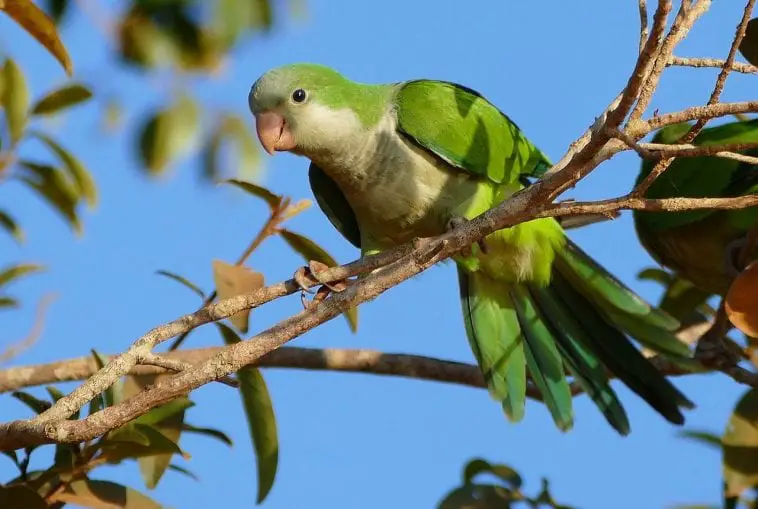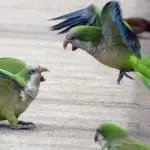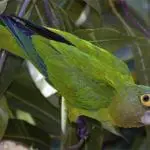Scientific Facts
| Common Name | Monk Parakeet |
| Scientific Name | Myiopsitta Monachus |
| Life Span | 6 years in the wild, 15 years in captivity |
| Size | 30 centimeters in length |
| Habitat | Savannas, gallery forests, gardens, agricultural lands, scrubs, and towns |
| Country of Origin | South America |
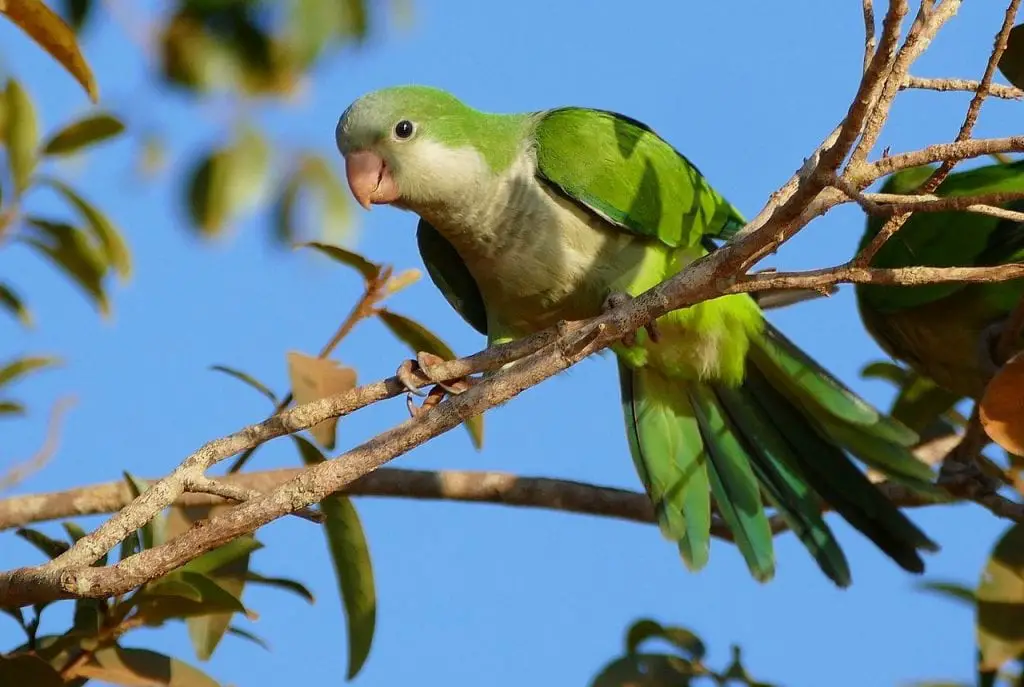
Physical Description
Monk Parakeets are little, sturdy parrots that measure around 30 centimeters in length with a wingspan that is 53 centimeters. They weigh around 90 to 120 grams. These creatures are mainly green with an off-white or gray face, breast, throat, and cheek. The vent area and lower abdomen are dazzling yellows. They have long and green tail feathers, and the flight feathers are mixed with blue and black. The legs are gray, and the bill is either pale yellow or pale orange. The iris is dark brown. Young Monk Parakeets are flashing green with a forehead that is also greenish.
These creatures do not display sexual dimorphism, which means that both sexes – male and female, have the same plumage. Generally, the male Monk Parakeets are a bit bigger compared to female Monk Parakeets, except during breeding season when it is noticed that the body mass of the female birds slightly increases. They are mostly seen in unconstrained groups of 15 to 20 birds – although groups that range up to 100 are not unusual.
Lifespan
In the wild, Monk Parakeets can live up to 6 years or even more. In captivity, these creatures can live 15 years. The lifespan of these creatures is determined by the kind of environment they are currently into. They must be given proper care with an ideal environment for them to achieve a longer life.
Eating Habits
Monk Parakeets are competent granivores and eat on maize, sunflowers, sorghum, millet, and other kinds of seeds, and also some fruits, berries, nuts, and insects. They are exceptionally great eaters. Throughout the year, favored foods include grass and thistle, and palm fruits, and other kinds of native trees, commonly tala. These creatures are very adaptable in terms of their eating habits. In their brought in range, Monk Parakeets eat fruits and seeds of bizarre exquisite plants as well as on bird seeds provided by humans year-round.
Monk Parakeets use their huge beak to feed on seeds and take chomps from huge portions of fruit. They were also noticed breaking pine cones to obtain the seeds and cutting off the head dandelions and feeding the seeds. During the winter season, these birds commonly feed in huge groups of several numbers while a few sentries settle on high branches and look for predators. During the season of breeding, groups that are bigger than 4 birds are very occasional. Generally, these creatures feed around 3.2 to 8 kilometers distant from the site of the nest and may forage as distant as 24 kilometers during the season of non-breeding.
Some Monk Parakeets happen to become overweight if permitted to luxuriate in too much fattening nuts as well as seed treats. This can lead to hypertension and liver problem. To avoid this scenario, make sure to provide your Monk Parakeet fresh greens, pasta, legumes, and other vegetables as the primary food source. Consider serving your pet a diet that is low in saturated fats and salt. Regularly secure freshwater for the Monk Parakeet.
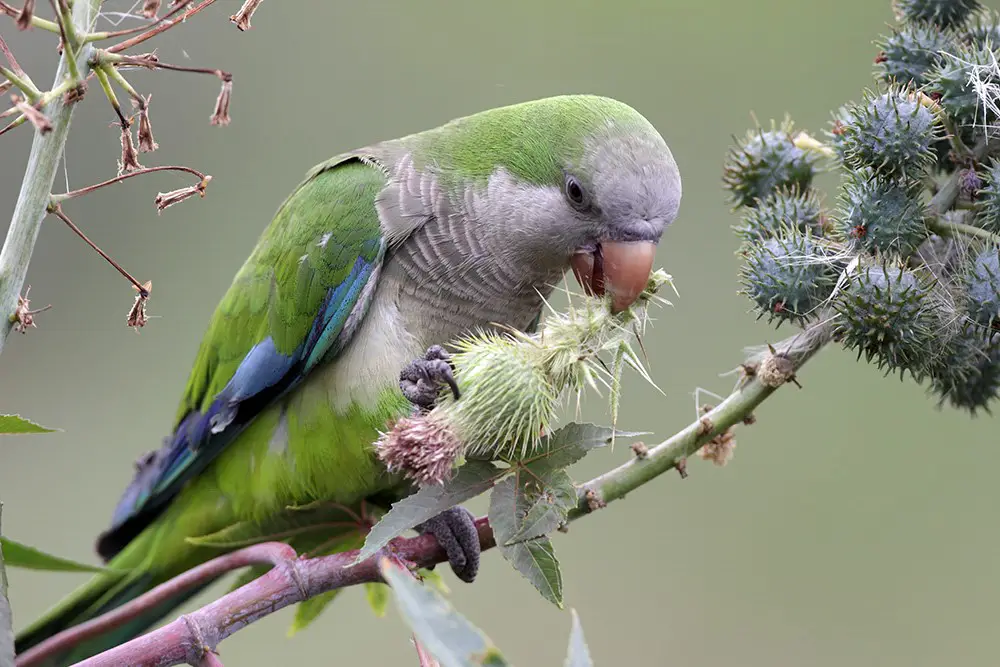
Sleeping Habits
One of the most remarkable behaviors of Monk Parakeets is their sleeping habits. They sleep upside-down, similar to bats.
Development and Reproduction
In South America, the development of gonadal starts in August culminates in November, and quickly declines from thereon. Monk Parakeets are the only species that build a nest through the materials of plants. Their eggs are white and commonly are laid every second day.
Testes expand to 15 times their usual size. Ovaries expand in the same proportion. This structure backs up the concept of a steady annual cycle compelled through a photoperiod. Based on observation, pairs release the first eggs during mid-October. The average size of the clutch is 7 eggs.
After abandoning the nest, the young parakeets usually stay close, creating their nests or building up an existing nest. Nests may be small, which can be enough to house a single pair or can measure up to 1-meter diameter and weigh around 200 kilograms and house many pairs. The nests have roofs as well as entry holes, which are chiefly on the underside and commonly numerous chambers for nesting pairs and minimal flocks of non-breeding individuals. Once the venue of the nest structure is chosen, each Monk Parakeet creates a nest cavity, attaching it to the structure of the main nest.
These creatures are very sociable, portraying 11 or even more various calls, which each brings out a unique reaction from others in the territory.

How to Breed
Determining the Sexes
Male and female Monk Parakeets have a similar appearance. Just as all monomorphic species of birds, the only method to determine the exact sex of a Monk Parakeet is through surgery or DNA sexing.
Courtship and Mating
These abiding birds form companionably restrained pairs. Courtship includes a pair preening one another and holding each other through their beaks chattering their heads. Flocks of Monk Parakeets will commonly create nests side by side. Every mating pair acquires its den, however, partake walls with their next-door neighbors to establish what has been known apartments or condominiums. Some have obtained an approximate 200 pounds and are similar to the size of a solid car.
Eggs and Incubation
Birds can lay 5 to 12 eggs. The eggs of Monk Parakeets hatched at different times after 24 days. The rate of the hatch was only over 50 percent. Hatchlings coated with yellow down. Their parents feed them through regurgitation for roughly 40 days. After this period, these hatchlings abandon the nest. The nestlings weigh around 106 grams before fledging.
Monk Parakeets in the wild commonly nest once a year, although up to 6 clutches a year are attainable.
Common Health Problems
Feather Destructive Behaviors
Feather destructive behaviors are the most common health issues among Monk Parakeets. These behaviors include feather plucking and fatty liver illness, which is related to a high-fat diet, particularly a seed-based diet.
Fatty Liver
Monk Parakeets tend to have fatty liver, especially if they are given an improper diet. If they eat too much, there is a tendency that they become overweight, and this shall commonly lead to fatty liver disease.
Preventing Illnesses
One effective way to prevent illnesses among Monk Parakeets is to serve them a good diet, which should be composed of a pelleted diet, complemented with fresh vegetables and fruits. Regularly clear up the cage together with the substrates. Regularly misting or bathing your pet through fresh chlorine-free water shall help remove dirt.
Behavior
Conceivably the unique discernable characteristic of the Monk Parakeet originates from its name – the quivering and quaking. These birds quiver and shake in a manner that appears relatively abnormal and alarming. However, it is indeed a natural demeanor absolute to these birds. Monk Parakeets are known to be very social. They may turn discouraged and mentally maladjusted if often left alone. They consume their entire lives living in humming territories of many individuals.
Each morning, these birds abandon their nests to scour, consuming the day plunging to the ground or clambering through trees to look for food. During the early evening, all of them assemble again at the nests to perch, both during the season of breeding and once it is done. These creatures allocate plenty of time preening one another.
They are the only group of parrot families to create stick nests and at the same time, nest territorially. Their hefty nests secure a home for territory all year-round. The covering these nests offer can be the main reason why these creatures can get through winters. One nest structure is commonly composed of up to 20 nest chambers. There are even cases wherein nest chambers reach up to 200. All members of a territory, counting in the non-breeders and the young birds, work to create and cultivate the nests.
These birds commonly opt for thorny branches for their nests; these can keep together better or contribute to shielding the nests from the predators. With these huge formations, pairs create new chambers by constructing the floor, then creating the roof and the sides to encase a round nest slot. Monk Parakeets are comparably blunt with a broad vocabulary of squawks, screeches, and cackling noises.
Monk Parakeets are not hesitant to men. They are seen in and near both huge and small towns. They are also seen in orchards and farms. If there is a sufficient source of food within reach, these creatures seldom roam far from the site of the nest. Nevertheless, in South America, except if they stay close to suburban and urban places where they can look for food throughout the year, Monk Parakeets travel during winter to search for better sources of food.
Monk Parakeets are bold and social by nature. They are mostly described as big birds in little bodies. Daring and demonstrative, they happen to babble a lot, and they are comparably dynamic little creatures. These creatures enjoy interacting with their group and are recognized in different places for their extraordinary talking capability.
Similar to other parrots, Monk Parakeets, who are ignored, will lead to feather plucking. They need incitement, and self-mutilation is usual, although not healthy, method parrots manage with apprehension and apathy.
In captivity, Monk Parakeets happen to acquaint very intimately with a person and are popular for their faithful nature. Many handfed Monk Parakeets are relatively compassionate, and a lot would make beautiful pets for younger owners of birds.
The only instance when these birds are noticed to demonstrate intrusiveness is when their home is endangered, or they are ignored. A disinterested parrot will not make a good company, and these little creatures require equal attention as the larger birds.
These creatures are popular for their alluring, entertaining characteristics, and their enthusiasm to learn speech. They are superior choices for bird fanatics who like to have the fun of a big parrot in a petite package. Monk Parakeets are famous pets, ideal for committed beginners, and adjust well to living in a group of people. These birds are magnificently captivating, and they are mostly labeled as little clowns. Many Monk Parakeets form an impressive vocabulary and may even assemble numerous phrases. They may get impudent, too, which simply plays into their spirited nature. Singing and mimicking sounds are other skills of this little charm.
The tone of these birds is subjective. Some handlers say that these birds are quiet-type, while others believe that they are very noisy. Undoubtedly, these birds are little chatterboxes, particularly if you put multiple birds in one room. People who are sensitive to noise may think thoroughly about owning this kind of bird. Monk Parakeets can wake up even the most solid sleeper. They may create disturbance in the neighborhood. On a positive note, these creatures are brilliant talkers. They are eminently trainable and can adapt tricks if properly driven by praise or food. If hand-raised, Monk Parakeets can be as caring and gentle as a buddy bird can be.
Habitat
Cage
Owners of Monk Parakeets should be prudent when selecting a cage because these birds are proficient in looking for ways to unlock and open their cages. The cage should be huge and should have enough space, cohabited with natural or wooden perches so they can conveniently fly from one branch to another. Considering their likeliness to break away, the bars must be distributed at a distance of 5/8 of an inch. The cage has to be at least 18 inches square, although they will do even better in the biggest one you can secure. Just see to it that it is durable. Cage doors should be made from stainless steel with opening exteriorities since those that are built from guillotine may harm them while trying to disengage it.
Monk Parakeets are very dynamic birds and require to have a sufficient amount of space for their playtime. These creatures do not only love chewing, but they are also known to learn how to open the cage and therefore escaping from it.
Toys
Secure your pet a lot of toys as well as a play gym as a venue to free their energy and play. Setting toys in the gym is always accepted. These toys will keep your pet busy. Also, a bath in the cage must be considered, and it should be another way of entertaining them.
The instinct of these birds to build nests is still alive in captive Monk Parakeets. Your pet may attempt to weave things in the cage’s bars or may opt to start nesting in the corner of your home through random kinds of stuff its finds. For this reason, it is recommended to oversee these inquisitive birds during the times they are permitted to be out from their cage to exercise.
This moment of being out of the cage is necessary to guarantee that your Monk Parakeet remains fit and happy. Plenty of small toys like smaller chew toys, bells, and balls will engross and encourage your pet during playtime activity. These creatures would love their toys to be in various shapes, colors, sizes, and purposes. These smart birds will commonly enjoy with puzzle toys.
Try introducing new toys at common intervals to avoid making them disinterested with similar stuff. You may also incorporate ladders and swings inside the cage.
Nest Box
Monk Parakeets are the only species in the family of parrot to create nests through sticks. Some of these creatures like making nests with just anything they grab in hands, such as shredded papers, toothpicks, pencils, and more. While selecting nest boxes for Monk Parakeets, see to it that you acquire some of their favored materials for nesting handy and harmless for them.
Temperature
Monk Parakeets are very strong birds. These birds can stand a dimension of climates, although they choose subtropical climates and warm temperatures. In its inherent range, these birds choose open forests, acacia, open woodland, savannah, farmland, scrubland, watercourses, orchards, palm groves, and is specifically typical close to human habitation.
Naturalized populations can endure life even in cold temperatures. Considering this fact, along with their productive breeding, feral territories of these creatures have been detected in numerous urban places in different parts of the world, counting in the United States.
Monk Parakeets will do best in average temperature, which must not go over 80 degrees Fahrenheit. Avoid placing the cage near the kitchen area because cooking fumes can be injurious for them. Although they are known to endure cold, do not expose them on drafts from air-conditioners, particularly while you are bathing your pet.
Diet
Monk Parakeets feed on buds, seeds, blossoms, fruits, nuts, and berries. There are times that these creatures will also feed on crops such as sorghum, corn, sunflower, rice, and wheat, directing to their prominence as agricultural pests, although this prominence stays hugely unconfirmed. In the winter season in the U.S., when these diets become insufficient, they also attack backyard bird feeders. Close to populated places, these birds have also been seen to feed on legumes, sweet potatoes, citrus crops, and drying meat.
They do better in homes if this diet is complemented with superior commercially prepared pellets and healthy seeds like chia seeds, flax, and hemp. The infrequent millet sprig is an accepted snack.
Just with all kinds of parrots, Monk Parakeets should be given fresh water. They should never be fed with chocolate, avocado, and coffee.
How to Care for Monk Parakeet
Although it is not difficult to get captivated with these charming little creatures and they are not costly, one should take some consideration before deciding to get one. Knowing that these creatures can accustom to living in various temperatures, they are not allowed to keep in certain places of the United States.
In certain places, specifically in southern states, feral Monk Parakeet populations have created breeding territories and suggest a danger to native bird species and crops. A small number of these states shall euthanize pet Monk Parakeets if they are seen. Make sure to verify with the Fish and Wildlife Service of the United States as well as your local laws to ensure that it is safe to keep a Monk Parakeet. This shall keep you and the bird away from trouble.
They are lots of Monk Parakeets who have obscured their homes for different reasons and are ready for adoption. Communicate with the nearest bird adoption foundation for details on how to raise one of these cheerful birds.
Since Monk Parakeets take satisfaction in their home, these creatures can become acquisitive over their cage too. If you are planning to introduce another Monk Parakeet to the one you already have at home, let them be familiarized with each other in different cages, and establish a bond first. Monk Parakeets are known to severely harm intruders, even leading to death.
If you own a cat or a dog in your home, you should also consider putting your concentration in your Monk Parakeet. It can be significantly daring and try to go up against the largest dogs. Although some hairy pets may be frightened with a feathered assailant, others will not.
If you can allocate time and patience to care for a Monk Parakeet, these creatures are comparably simple to fix up in comparison to other kinds of parrots. Most of the time, it is the interrupted bond with their original handler that disturbs them the most. Monk Parakeets just like to be loved and be belonged to what they deem their flock. If you give sufficient attention and love, they may turn around.
Monk Parakeets are rapacious chewers and can do rapid work of furniture. Hence, provide plenty of safe branches and chewable toys to inhibit living an uninterested and sad Monk Parakeet that can readily convert its damaging nature onto the invaluable. Nails should also be trimmed to inhibit any injuries. You may also consider bringing your pet to a professional groomer to do the nail trimming. Some owners opt to clip their wings to stop them from flying around or escaping devastatingly.
The moment you establish a bond to a Monk Parakeet, you will relish on years of togetherness. They take pleasure in snuggling and being caressed on the head, and a lot of owners are longing for the delighted squeaks that welcome them when they reach home.
Availability – Where to Get One
There is a potential market for Monk Parakeets as pets. If you want to get a Monk Parakeet as your pet, you may consider checking on various pet stores. Many breeders have also strived to achieve high valued parakeets. Some available Monk Parakeets are cinnamon, albino, pied, yellow, and blue.
However, you must remember that Monk Parakeets are so productive and harmful if they conquer in the wild. They are not legal to sell. People are not allowed to own one in some states. Therefore, it is always advised to verify the state laws before you decide to buy or sell a Monk Parakeet. Moreover, take into account the laws of the states you may like to explore or move to if you have a Monk Parakeet already. These creatures have been seized and euthanized in states where ownership of these birds are not allowed.
Some states do not allow the selling and buying of Monk Parakeets because of the risk of breeding populations turning ratified in the wild. These creatures are said to post risk in agriculture. They are agricultural pests since flocks can destroy planted crops, fruits, and grains. When Monk Parakeets set up wild bleeding territories, they may assertively outcompete the native animals for food. Also, when Monk Parakeets nest on electrical utility poles, substations, and transformers, Monk Parakeets may destroy the power lines. The extent of their nest hampers with utility equipment resulting in fires, power outages, and short circuits.
FAQs
Are Monk Parakeets trainable?
Yes. These creatures have sharp brains. They have promising reactions when it comes to training. Play some soothing music to help your pet feel calmed and enthralled. Establish a strong bond with your pet.
They said that Monk Parakeets are not legally sold and bought, should I be discouraged from getting one?
Although many states are not permitting the selling and buying of these birds, some places are still allowing them for ownership. It is recommended that you verify first the laws of the state to confirm whether or not it allows Monk Parakeets as pets.
Do they talk?
Yes. Monk Parakeets can talk and can pick up several words, phrases, and some complicated vocabularies. However, they have to be taught with this trick, and therefore the owner should have the patience and determination to teach his pet to talk.
How can I establish a strong bond with my Monk Parakeet?
Make sure to provide your pet enough time and effort. As often as possible, play with your pet. Monk Parakeets want to receive affection. Eventually, your pet will be so attached to you, and you can then establish a very strong bond.

